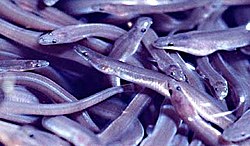American Eel (Anguilla rostrata)
From The Aquarium Wiki
American Eel
Anguilla rostrata
1136 Litres (300 US G.)
114.3-147.3cm (45-58 ")
7.5 - 8.2
10-23.9°C (50 -75 °F)
8-18 °d
1:1 M:F
25-43 years
Family
Anguillidae
Contents
Additional names
- American Eel, American Freshwater Eel, Anguila Eel, Common Eel, European Eel, European Freshwater Eel, Silver Eel
Additional scientific names
- Muraena rostrata, Anguilla aterrima, Anguilla blephura, Anguilla chrisypa, Anguilla cubana, Anguilla laticanda, Anguilla laticauda, Anguilla lutea, Anguilla macrops, Anguilla novaeorleanensis, Anguilla novaeterrae, Anguilla punctatissima, Anguilla tenuirostris, Anguilla texana, Anguilla tyrannus, Anguilla wabashensis, Anguilla xanthomelas, Leptocephalus grassii, Muraena argentea, Muraena bostoniensis, Muraena macrocephala, Muraena serpentina
Origin[edit]
- Northwest to western Central Atlantic: Greenland south along the Atlantic coast of Canada and the USA to Panama, and throughout much of the West Indies south to Trinidad.
Sexing[edit]
- Males are smaller than females.
Tank compatibility[edit]
- Peaceful towards other fish provided they are larger than its mouth. Will pose a threat to smaller fish.
Diet[edit]
- A scavenger that will take most foods, will eat most foods provided and scavenge detritus.
Feeding regime[edit]
- Feed once or twice a day.
Environment specifics[edit]
- This fish is found in fresh, brackish and saltwater, but spends most of its life in freshwater. Provide this fish with large hiding places and soft substrate with good filtration.
Behaviour[edit]
- A nocturnal fish that will spend most of the day time hidden or buried in substrate.
Identification[edit]
- There are two regional variants of this fish, the American and the European. The only significant difference being that the European variety grows much slower than the American.
- This is a very elongated fish with variable colouration. Adults are usually white or light-coloured below and brownish to blue-black above. The head is long with the small eyes set well forward. The caudal fin is rounded and joined to the dorsal and anal fins.
Pictures[edit]
Videos[edit]
| Feeding on bloodworms: |
External links[edit]
- Fishbase (Mirrors:
 )
)
